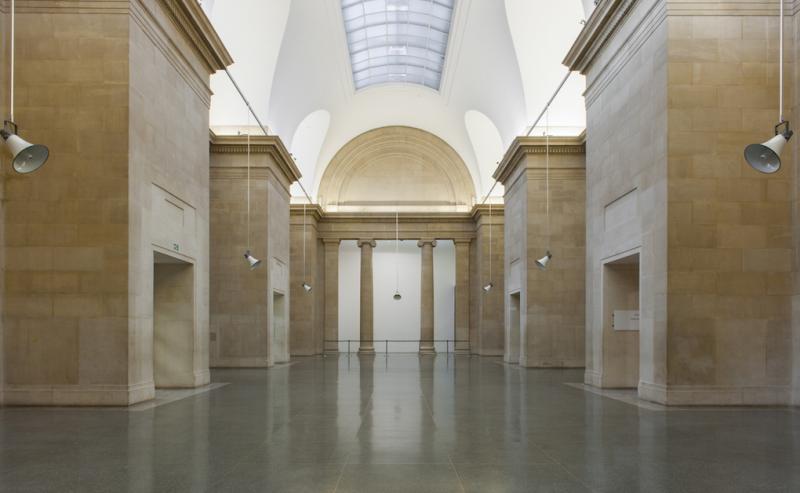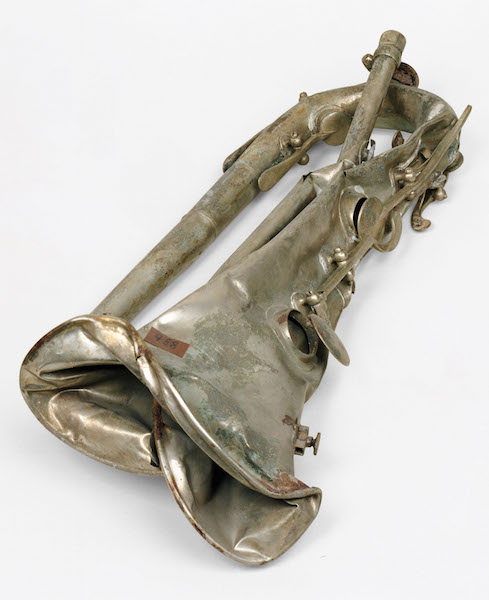Susan Philipsz: War Damaged Musical Instruments, Tate Britain | reviews, news & interviews
Susan Philipsz: War Damaged Musical Instruments, Tate Britain
Susan Philipsz: War Damaged Musical Instruments, Tate Britain
A hauntingly evocative sound installation marking World War One

Tate Britain’s Duveen Galleries are currently filled with a hauntingly beautiful sound installation by Susan Philipsz (main picture). The Scottish artist won the Turner Prize in 2010 for a sound piece that didn’t really work at the Tate. Intended to be heard under the bridges spanning the River Clyde in Glasgow, the recording of Philipsz's fragile voice singing sad folk songs was largely drowned out by ambient noise.
This time, though, she has been able to design the installation especially for this awesome space, which stands empty for the occasion. A central line of speakers hanging from the ceiling is augmented by others attached to pillars to create an evocative 3D soundscape. Notes from “The Last Post”, familiar from Remembrance ceremonies and military funerals, are played on brass and woodwind instruments damaged in battles over the last 200 years.
The oldest are two bugles – one from the 1815 Battle of Waterloo, found beside the body of a 14-year-old drummer boy, and another from the Crimean War of 1854, blown by William Brittain of the 17th Lancers to sound the infamous Charge of the Light Brigade during the Battle of Balaclava. The most recent – a keyed bugle and two transverse flutes – were found in the Alte Münz Bunker in Berlin in 1945. (Pictured below right: Klappenhorn [ruin]).
 Philipsz was curious to see what sounds could be elicited from these severely battered relics, all of which are housed in British and German military museums. On video, one can watch various musicians attempting to play them, often producing little more than the sound of their own breath being funnelled through mangled tubing. “I am less interested in creating music than to see what sounds these instruments are still capable of”, Philipsz explains, “even if that sound is just the breath of the player as he or she exhales through the battered instrument.”
Philipsz was curious to see what sounds could be elicited from these severely battered relics, all of which are housed in British and German military museums. On video, one can watch various musicians attempting to play them, often producing little more than the sound of their own breath being funnelled through mangled tubing. “I am less interested in creating music than to see what sounds these instruments are still capable of”, Philipsz explains, “even if that sound is just the breath of the player as he or she exhales through the battered instrument.”
Watching a young man put his lips to a crumpled instrument is a moving experience; it makes one aware of the damage that weaponry can inflict on metal and flesh and brings into sharp focus the moment when the original player was probably killed or wounded. But it's the sounds themselves that are the most evocative. They travel round the empty space paying melancholy tribute to all those who lost their lives. Commissioned by 14-18 NOW, a programme of events marking the centenary of the First World War, this wonderfully restrained piece would certainly have deserved the Turner Prize.
rating
Explore topics
Share this article
The future of Arts Journalism
You can stop theartsdesk.com closing!
We urgently need financing to survive. Our fundraising drive has thus far raised £49,000 but we need to reach £100,000 or we will be forced to close. Please contribute here: https://gofund.me/c3f6033d
And if you can forward this information to anyone who might assist, we’d be grateful.

Subscribe to theartsdesk.com
Thank you for continuing to read our work on theartsdesk.com. For unlimited access to every article in its entirety, including our archive of more than 15,000 pieces, we're asking for £5 per month or £40 per year. We feel it's a very good deal, and hope you do too.
To take a subscription now simply click here.
And if you're looking for that extra gift for a friend or family member, why not treat them to a theartsdesk.com gift subscription?
more Visual arts
 'We are bowled over!' Thank you for your messages of love and support
Much-appreciated words of commendation from readers and the cultural community
'We are bowled over!' Thank you for your messages of love and support
Much-appreciated words of commendation from readers and the cultural community
 Lee Miller, Tate Britain review - an extraordinary career that remains an enigma
Fashion photographer, artist or war reporter; will the real Lee Miller please step forward?
Lee Miller, Tate Britain review - an extraordinary career that remains an enigma
Fashion photographer, artist or war reporter; will the real Lee Miller please step forward?
 Kerry James Marshall: The Histories, Royal Academy review - a triumphant celebration of blackness
Room after room of glorious paintings
Kerry James Marshall: The Histories, Royal Academy review - a triumphant celebration of blackness
Room after room of glorious paintings
 Folkestone Triennial 2025 - landscape, seascape, art lovers' escape
Locally rooted festival brings home many but not all global concerns
Folkestone Triennial 2025 - landscape, seascape, art lovers' escape
Locally rooted festival brings home many but not all global concerns
 Sir Brian Clarke (1953-2025) - a personal tribute
Remembering an artist with a gift for the transcendent
Sir Brian Clarke (1953-2025) - a personal tribute
Remembering an artist with a gift for the transcendent
 Emily Kam Kngwarray, Tate Modern review - glimpses of another world
Pictures that are an affirmation of belonging
Emily Kam Kngwarray, Tate Modern review - glimpses of another world
Pictures that are an affirmation of belonging
 Kiefer / Van Gogh, Royal Academy review - a pairing of opposites
Small scale intensity meets large scale melodrama
Kiefer / Van Gogh, Royal Academy review - a pairing of opposites
Small scale intensity meets large scale melodrama
 Jenny Saville: The Anatomy of Painting, National Portrait Gallery review - a protégé losing her way
A brilliant painter in search of a worthwhile subject
Jenny Saville: The Anatomy of Painting, National Portrait Gallery review - a protégé losing her way
A brilliant painter in search of a worthwhile subject
 Abstract Erotic, Courtauld Gallery review - sculpture that is sensuous, funny and subversive
Testing the boundaries of good taste, and winning
Abstract Erotic, Courtauld Gallery review - sculpture that is sensuous, funny and subversive
Testing the boundaries of good taste, and winning
 Edward Burra, Tate Britain review - watercolour made mainstream
Social satire with a nasty bite
Edward Burra, Tate Britain review - watercolour made mainstream
Social satire with a nasty bite
 Ithell Colquhoun, Tate Britain review - revelations of a weird and wonderful world
Emanations from the unconscious
Ithell Colquhoun, Tate Britain review - revelations of a weird and wonderful world
Emanations from the unconscious
 Rachel Jones: Gated Canyons, Dulwich Picture Gallery review - teeth with a real bite
Mouths have never looked so good
Rachel Jones: Gated Canyons, Dulwich Picture Gallery review - teeth with a real bite
Mouths have never looked so good

Add comment